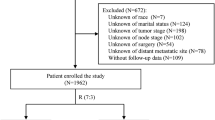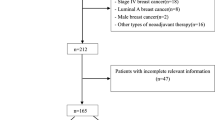Abstract
Women starting first-line chemotherapy for advanced breast cancer have differing baseline characteristics and survival times. We sought to develop and validate a pragmatic prognostic nomogram to predict overall survival (OS) by using available clinical and laboratory data. The prognostic model was developed in a training cohort (n = 693) from two first-line chemotherapy trials (ANZ8101 and ANZ8614) and validated in two other trials (ANZ0001 and ANZ9311) with 324 and 233 patients, respectively. The proportional-hazards model was constructed from pretreatment demographic and disease characteristics. Patients were classified into good (score <88), medium (88–157), and poor (>157) prognostic groups. A nomogram was constructed (n = 1250) from the combined datasets of all four trials, based on the predictors identified in the training cohort. The nomogram predicted OS with a concordance index of 0.65 (95%CI, 0.62–0.67). Factors in the nomogram were age, performance status, estrogen receptor status, number of involved organs (lung, liver and brain), hemoglobin concentration, neutrophil count, and serum alkaline phosphatase. The median survival for good, medium, and poor prognosis was 15.4 months (95%CI, 12.7–19.1), 10.2 months (95%CI, 9.0–11.6), and 6.1 months (95%CI, 4.4–6.7), respectively. The actual and model-predicted probabilities of 18-month survival agreed well, after recalibration for the new baseline survival functions for each validation cohort. A nomogram combining seven readily available baseline characteristics enabled stratification of advanced breast cancer patients into three groups with significantly different survival times. This nomogram could be useful for individualising treatment and for stratifying patients in future randomized trials.





Similar content being viewed by others
References
Goldhirsch A, Ingle JN, Gelber RD, Coates AS, Thurlimann B, Senn H-J (2009) Thresholds for therapies: highlights of the St Gallen International expert consensus on the primary therapy of early breast cancer 2009. Ann Oncol 20:1319–1329
Greene F, Page D, Fleming I et al (2002) AJCC cancer staging manual American joint committee on cancer. Chicago, IL
Galea M, Blamey R, Elston C, Ellis I (1992) The Nottingham prognostic index in primary breast cancer. Breast Cancer Res Treat 22:207–219
Ravdin PM, Siminoff LA, Davis GJ et al (2001) Computer program to assist in making decisions about adjuvant therapy for women with early breast cancer. J Clin Oncol 19:980–991
Largillier R, Ferrero J-M, Doyen J et al (2008) Prognostic factors in 1038 women with metastatic breast cancer. Ann Oncol 19:2012–2019
Gennari A, Conte P, Rosso R, Orlandini C, Bruzzi P (2005) Survival of metastatic breast carcinoma patients over a 20-year period. Cancer 104:1742–1750
Hortobagyi G, Smith T, Legha S et al (1983) Multivariate analysis of prognostic factors in metastatic breast cancer. J Clin Oncol 1:776–786
Chang J, Clark GM, Allred DC, Mohsin S, Chamness G, Elledge RM (2003) Survival of patients with metastatic breast carcinoma. Cancer 97:545–553
Ryberg M, Nielsen D, Osterlind K, Skovsgaard T, Dombernowsky P (2001) Prognostic factors and long-term survival in 585 patients with metastatic breast cancer treated with epirubicin-based chemotherapy. Ann Oncol 12:81–87
Yamamoto N, Watanabe T, Katsumata N et al (1998) Construction and validation of a practical prognostic index for patients with metastatic breast cancer. J Clin Oncol 16:2401–2408
Swenerton KD, Legha SS, Smith T et al (1979) Prognostic factors in metastatic breast cancer treated with combination chemotherapy. Cancer Res 39:1552–1562
Sledge GW, Neuberg D, Bernardo P et al (2003) Phase III trial of doxorubicin, paclitaxel, and the combination of doxorubicin and paclitaxel as front-line chemotherapy for metastatic breast cancer: an intergroup trial (E1193). J Clin Oncol 21:588–592
Stockler MR, Tattersall MHN, Boyer MJ, Clarke SJ, Beale PJ, Simes RJ (2005) Disarming the guarded prognosis: predicting survival in newly referred patients with incurable cancer. Br J Cancer 94:208–212
Viganò A, Dorgan M, Bruera E, Suarez-Almazor ME (1999) The relative accuracy of the clinical estimation of the duration of life for patients with end of life cancer. Cancer 86:170–176
Vigano A, Bruera E, Jhangri GS, Newman SC, Fields AL, Suarez-Almazor ME (2000) Clinical survival predictors in patients with advanced cancer. Arch Intern Med 160:861–868
Glare P, Virik K, Jones M et al (2003) A systematic review of physicians’ survival predictions in terminally ill cancer patients. BMJ 327:195
Coates A, Gebski V, Bishop J et al (1987) Improving the quality of life during chemotherapy for advanced breast cancer. A comparison of intermittent and continuous treatment strategies. N Engl J Med 317:1490–1495
Simes R, Gebski V, Coates A et al (1994) Quality of life with single agent mitozantrone or combination chemotherapy for advanced breast cancer, a randomised trial. Proc Am Soc Clin Oncol 13:73
Stockler M, Sourjina T, Harvey V et al (2007) A randomized trial of capecitabine given intermittently versus continuously versus classical CMF as first line chemotherapy for women with advanced breast cancer unsuited to more intensive treatment. Breast Cancer Res Treat 100:S278
Ackland S, Gebski V, Wilson A et al (2000) High dose epirubicin & cyclophosphamide (HDEC) with filgrastim versus standard dose (SDEC) in advanced breast cancer—a quality of life study by the anz breast cancer trials group. Proc Am Soc Clin Oncol 19 (abstr 288)
Kaplan EL, Meier P (1958) Nonparametric estimation from incomplete observations. J Am Stat Assoc 53:457–481
Cox DR (1972) Regression models and life-tables. J Royal Stat Soc 34:187–220
Harrell F Jr, Lee K, Mark D (1996) Multivariable prognostic models: issues in developing models, evaluating assumptions and adequacy, and measuring and reducing errors. Stat Med 15:361–387
Harrell F Jr (2001) Regression modeling strategies: with applications to linear models, logistic regression and survival analysis. Springer, New York
Lee CK, Lord SJ, Stockler MR, Coates AS, Gebski V, Simes RJ (2010) Historical cross-trial comparisons for competing treatments in advanced breast cancer—an empirical analysis of bias. Eur J Cancer 46:541–548
Kattan MW, Scardino PT (2002) Prediction of progression: nomograms of clinical utility. Clin Prostate Cancer 1:90–96
Henderson R, Keiding N (2005) Individual survival time prediction using statistical models. J Med Ethics 31:703–706
Dunkler D, Michiels S, Schemper M (2007) Gene expression profiling: does it add predictive accuracy to clinical characteristics in cancer prognosis? Eur J Cancer 43:745–751
Kattan M (2002) Statistical prediction models, artificial neural networks, and the sophism “I Am a Patient, Not a Statistic”. J Clin Oncol 20:885–887
Ghersi D, Wilcken N, Simes RJ (2005) A systematic review of taxane-containing regimens for metastatic breast cancer. Br J Cancer 93:293–301
Slamon DJ, Leyland-Jones B, Shak S et al (2001) Use of chemotherapy plus a monoclonal antibody against HER2 for metastatic breast cancer that overexpresses HER2. N Engl J Med 344:783–792
Miller K, Wang M, Gralow J et al (2007) Paclitaxel plus bevacizumab versus paclitaxel alone for metastatic breast cancer. N Engl J Med 357:2666–2676
Geyer CE, Forster J, Lindquist D et al (2006) Lapatinib plus capecitabine for HER2-positive advanced breast cancer. N Engl J Med 355:2733–2743
Saad ED, Katz A, Buyse M (2010) Overall survival and post-progression survival in advanced breast cancer: a review of recent randomized clinical trials. J Clin Oncol 28:1958–1962
Lee CK, Stockler MR, Coates AS, Gebski V, Lord SJ, Simes RJ (2010) Self-reported health-related quality of life is an independent predictor of chemotherapy treatment benefit and toxicity in women with advanced breast cancer. Br J Cancer 102(9):1341–1347
Seshadri R, Firgaira F, Horsfall D, McCaul K, Setlur V, Kitchen P (1993) Clinical significance of HER-2/neu oncogene amplification in primary breast cancer. The South Australian breast cancer study group. J Clin Oncol 11:1936–1942
Slamon D, Godolphin W, Jones L et al (1989) Studies of the HER-2/neu proto-oncogene in human breast and ovarian cancer. Science 244:707–712
Bartsch R, Rottenfusser A, Wenzel C et al (2007) Trastuzumab prolongs overall survival in patients with brain metastases from Her2 positive breast cancer. J Neurooncol 85:311–317
Slamon D, Clark G, Wong S, Levin W, Ullrich A, McGuire W (1987) Human breast cancer: correlation of relapse and survival with amplification of the HER-2/neu oncogene. Science 235:177–182
Toikkanen S, Helin H, Isola J, Joensuu H (1992) Prognostic significance of HER-2 oncoprotein expression in breast cancer: a 30-year follow-up. J Clin Oncol 10:1044–1048
Bewick M, Conlon M, Gerard S et al (2001) HER-2 expression is a prognostic factor in patients with metastatic breast cancer treated with a combination of high-dose cyclophosphamide, mitoxantrone, paclitaxel and autologous blood stem cell support. Bone Marrow Trans 27:847–853
Kiely BE, Soon YY, Tattersall MHN, Stockler MR (2011) How Long Have I Got? Estimating typical, best-case, and worst-case scenarios for patients starting first-line chemotherapy for metastatic breast cancer: a systematic review of recent randomized trials. J Clin Oncol 29:456–463
Schapira L (2011) Simple rules can improve prognostic accuracy. J Clin Oncol 29:347–349
Acknowledgments
We thank Ms Rhana Pike for the editorial support. This study was supported by National Breast Cancer Foundation Doctoral Research Scholarship for Dr CK Lee.
Author information
Authors and Affiliations
Corresponding author
Rights and permissions
About this article
Cite this article
Lee, C.K., Hudson, M., Stockler, M. et al. A nomogram to predict survival time in women starting first-line chemotherapy for advanced breast cancer. Breast Cancer Res Treat 129, 467–476 (2011). https://doi.org/10.1007/s10549-011-1471-9
Received:
Accepted:
Published:
Issue Date:
DOI: https://doi.org/10.1007/s10549-011-1471-9




